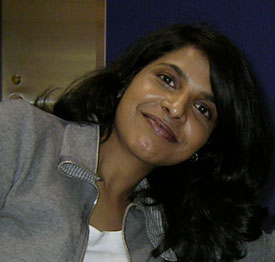By Karthika Swamy Cohen
Hearing loss, which can be caused by exposure to loud sounds, affects about 360 million people worldwide, which makes up over 5 percent of the world’s population. Noise from say, explosions or gun shots can cause traumatic injuries to the auditory system.
At a minisymposium talk titled “Effect of Biovariability on Observed Risk of Hearing Loss” at the SIAM Annual Meeting being held in Portland, Ore. this week, Hong Zhou of Naval Postgraduate School described how biovariability among individuals can result in a wide range of injury probabilities among people in a crowd. While many previous studies trying to answer this question assumed that all subjects in the crowd would respond the same way to such impulses, Zhou’s group factored in the effect of heterogeneity.
Physiologic differences among people and even within the same individual over time can cause these sorts of variations in responses. Just like there exists variability in biologically-inherited traits like height, weight, and skin color, responses to stimuli also differ greatly in a crowd of animal or human subjects. Therefore, it’s not surprising that certain individuals may be more or less vulnerable to hearing loss injury than others.
One cause for such variability is that body temperature can affect sensitivity to noise. So what function does biological variability play when a crowd is exposed to multiple acoustic impulses?
Chinchillas are used as surrogate animal models in hearing loss studies due to their similarities to humans in hearing capabilities.
The hearing loss injury experiments were conducted in chinchillas, which were chosen as surrogate animal models due to their similarities to humans in hearing capabilities. Small shock tubes were placed at various distances to each chinchilla covering a range of intensity levels, following which each animal’s injury status was measured and recorded. Data of these results were them assembled to mimic the collective response of a crowd to impulse noises.
Since the threshold for injury susceptibility of chinchillas is lower than humans, the chinchilla data were shifted by 28 dBA to scale to humans. The scaled data was then used to formulate an empirical injury model for humans exposed to multiple sound impulses of equal intensity.
Zhou’s group mathematically derived the distribution density of individual injury probability in a crowd, which would reproduce the observed dose-response relation. They demonstrated that the derived distribution is a proper density function for several parameter values relevant for applications. The team’s results indicate that it is possible to interpret the observed logistic dose-response relation based on biovariability.
They showed that the injury risk of the crowd caused by multiple impulses is significantly less as compared to the risk predicted on the assumption that all individuals are statistically identical and all impulses act independently in causing injury.
The study thus revealed that some subjects are biologically less or more susceptible to hearing loss injury than others.
Zhou’s team previously used the framework of immunity to interpret the empirical dose-response relation for multiple sound impulse exposure. This revealed that the phenomenological effect of a sound exposure event on a subsequent sound exposure event is always immunity. Thus, immunity and biovariability comprise two different views to explain the empirical dose response relation.
 |
Karthika Swamy Cohen is the managing editor ofSIAM News. |